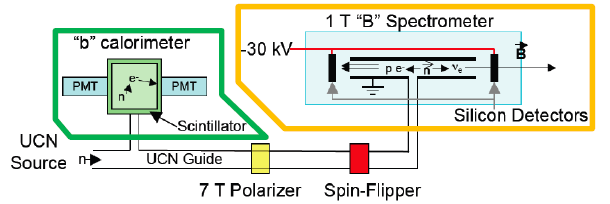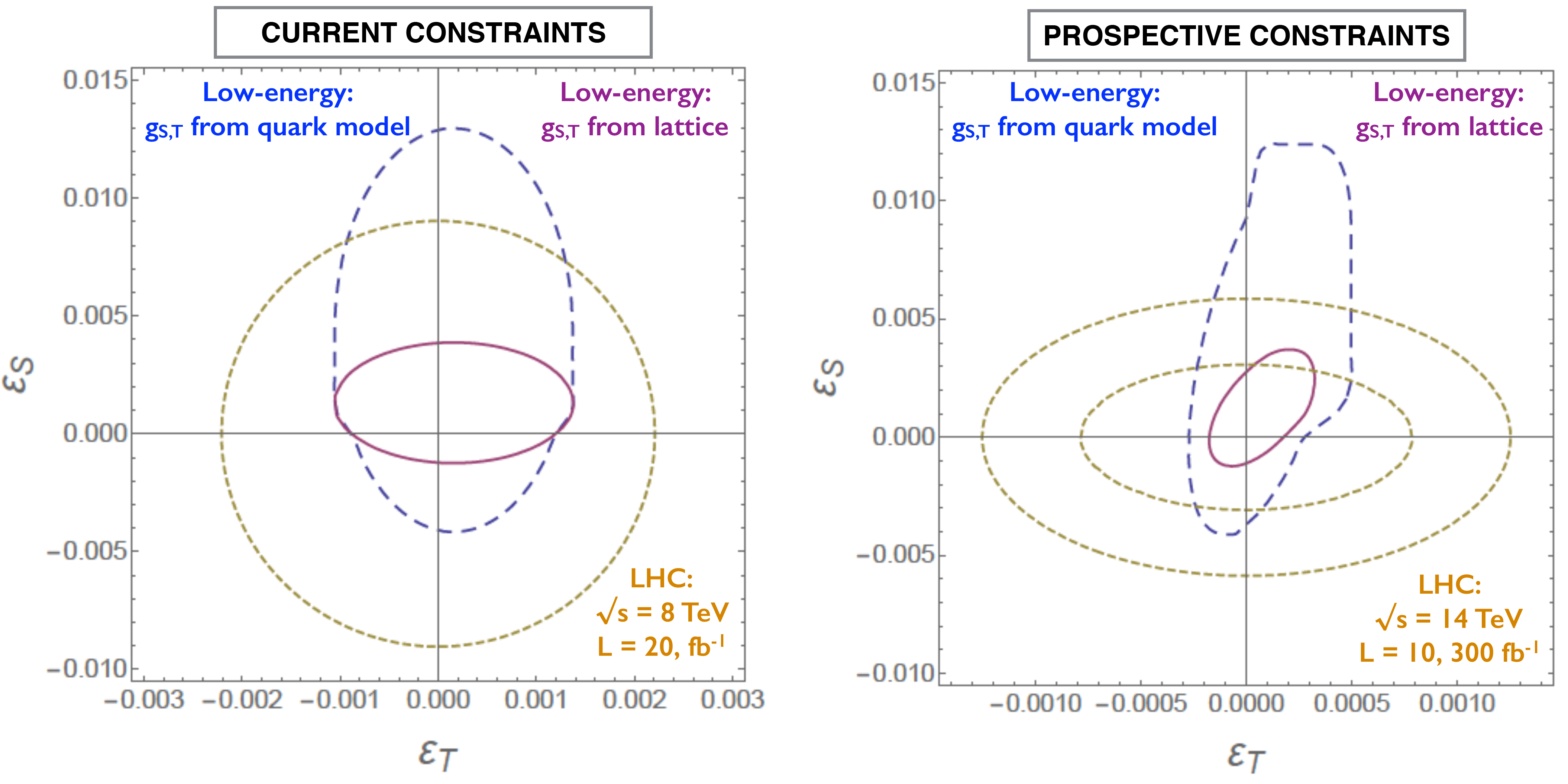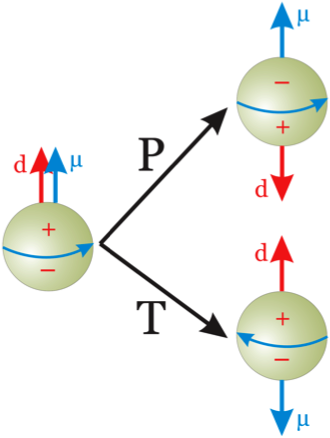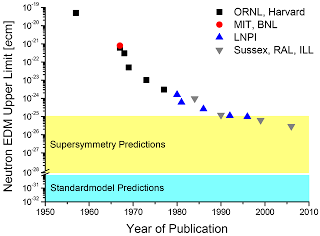Precision Nucleon
Decay Matrix Elements (PNDME)
using 2+1+1-flavor HISQ Fermions
The quest of high energy and nuclear physicists is to understand the universe in terms of fundamental interactions and particles and address questions such as: What extension of the standard model describes nature at the TeV scale? Where do the masses of fundamental particles come from? Why is the observed universe predominately matter? What is the nature of dark matter and dark energy? These questions are being addressed both at the high energy frontier at the LHC and through high precision experiments at scales all the way from ultracold neutrons, to physics of c and b quarks, to neutrinos from accelerators, astrophysical events, and nuclear decays. On the theory side, to constrain the many candidate extensions of the standard model one needs to calculate the predictions of the standard model and look for deviations due to possible novel interactions. A key challenge to calculations involving quarks and gluons (they also impact processes mediated by elctromagnetic and weak interactions through quantum corrections) are the corrections due to strong interactions described by Quantum Chromodynamics (QCD). In the hadronic world (below few GeV), these corrections can be large since the coupling constant is order unity and non-perturbative methods are needed. For many quantities large scale simulations of Lattice QCD are providing (or can provide) estimates with control over all systematics and of accuracy required to interpret experiments and test candidate theories. This project is focused on a number of quantities that elucidate the structure of the nucleon and probe new physics at the TeV scale.
Goal
Our goal is to provide increasingly high precision calculations of matrix elements (ME) of bilinear quark operators within nucleon states. These ME are needed to complement experimental measurements of nucleon structure and properties and probe new physics beyond the standard model (BSM) of elementary particles and their interactions. The basic idea is that new interactions at the TeV and higher energy scales give rise to tiny corrections to the properties of nucleons (protons and neutrons) in low energy processes involving them. By the combined effort, measuring these possible subtle deviations from predictions of the standard model in ongoing and upcoming low-energy precision experiments and calculating the matrix elements of novel interactions, one can constrain the parameter space of possible BSM theories. This approach to discovery is complementary to experiments being done at the highest energies at the LHC at CERN, where one aims to directly detect new particles and interactions, such as the recent discovery of the Higgs boson.
Method
The proposed calculations of matrix elements are being done using large scale simulations of lattice Quantum Chromodynamics (QCD). Precise estimates of QCD corrections to a variety of matrix elements of bilinear quark operators between nucleon states on ensembles of gauge configurations generated with 2+1+1-flavors of dynamical HISQ fermions generated by the MILC collaboration at multiple values of lattice spacing and quark masses. These calculations will allow us to extract a variety of low-energy observables that will elucidate the structure of nucleons and probe the presence of new interactions beyond the Standard Model at the TeV scale. By performing simulations at multiple values of lattice spacings and quark masses, including the physical mass, we will be able to demostrate control over all sources of systematic errors. The toolkit being used includes:
- The truncated solver method with bias correction (also called the all-mode-averaging (AMA) method) {collins:2007mh,Blum:2012uh}. We show that inverting the quark propagator with the residual set to r = (solution-source)/source = 10-3 gives rise to no detectable bias in the estimates of 2-point and 3-point functions. Our results, nevertheless, include the possible bias correction term. The lower precision calculations are, however, a factor of about 17 faster.
- The multigrid method was used to invert the Dirac operator. It significantly reduces the critical slowing down, i.e., the increase in the number of iterations is small as the light quark mass is reduced to its physical value.
- The coherent source sequential propagator method was used to reduce the number of inversions required. We demonstrated that this approach does not significantly increase the errors. Processing 4 source points in a single computer job with 5 values of the source-sink separation tsep reduced the number of inversions from (4+4x2x5=44) to (4+2x5=14).
- A number of values (3—5) of the source-sink separation tsep are analyzed in each calculation to understand and reduce excited-state contamination.
- A simultaneous 2-state fit to the 3-point function data at all the different source-sink separation tsep was made. These fits allowed us to estimate the transition matrix elements <0 | OA | 1 > and <1 | OA | 1 > in addition to the desired ground state matrix element <0 | OA | 0 > . The 2-state fit, by taking into account the excited-state contamination provides, provides an estimate of the tsep → ∞ value. Three state analysis is being tested.
- The nine HISQ ensembles analyzed covered the range 0.012—0.06 fm in lattice spacing a, 320—135 MeV in the pion mass Mπ, and 3.3—5.5 in Mπ L. With high statistics measurements on each of the 9 ensembles we made the first simultaneous fit in the three variables a, Mπ and Mπ L to obtain results in the limit a → 0, Mπ L → ∞ and the physical light quark mass defined by Mπ = 135 MeV.
Ongoing Calculations
The matrix elements within nucleon states are being calculated using ensembles of 2+1+1-flavor HISQ fermions generated by the MILC collaboration. They will provide estimates of:
- The axial charge of nucleons that encapsulates the strength of weak interactions of the nucleons.
- The isovector tensor and scalar charges that are needed to probe possible scalar and tensor interactions at the TeV scale in beta-decay of [ultra]cold-neutrons. The tensor charge also gives the lowest moment of the transversity parton distribution.
- Contributions of new CP violating interactions to the electric dipole moment of the neutron.
- Electromagnetic form-factors of the nucleons, from which their charge radii will be extracted and compared with measurements made in electron scattering and muon capture experiments.
- Axial form factors that are needed to improve estimates of neutrino cross-section with nuclear matter. These energy dependent cross-sections are needed to determine the neutrino flux in precision neutrino oscillation experiments.
- Spatial, momentum, and angular distribution of quark and gluons within nucleons and how each constituent contributes to the nucleon spin.
Results and Expected Results
-
Our current clover-on-HISQ lattice QCD estimate of the axial
charge gA=1.195(33)(20) lies about 7% below the
precisely measured experimental value 1.276(2). Our goal is
to reduce the uncertainty to less than 2%.
[Phys. Rev. D94 (2016) 054508] -
Current estimates of the scalar and tensor charges are
gS=0.97(12)(6)
and gT=0.987(51)(20). Our goal is to to
reduce the uncertainty in the tensor
charge gT to 2% and
in gS to 10%. This level of precision
will complement experimental precision of 10−3
in the measurement of b and B1
parameters in neutron beta-decay and constrain novel scalar
and tensor couplings at the TeV at the 10−3
level. Current and prospective bounds are shown below.
[Phys. Rev. D94 (2016) 054508] - Using our results for the
ratio gS/gS we can predict using CVC the
ratio (Mn-Mp)/(md-mu)=2.59(49)
MeV for pure QCD. Our goal is to reduce the errors by a factor of three.
[Phys. Rev. D94 (2016) 054508] -
Results for the flavor diagonal charges of the proton are
gTu=0.792(42),
gTd=-0.194(14)
and gTs=0.008(9). These have
been used to bound the quark EDM couplings. We are working to
reduce the uncertainty in the contribution of the
disconnected diagrams to O(10%) and overall uncertainty to O(20%)
in the charges gTs and
gTc that get enhanced relative to
gTu,
gTd
in Higgs-like theories by the ratio of quark masses.
[Phys. Rev. D92 (2015) 094511; Phys. Rev. Lett115 (2014) 212002; Phys. Rev. D94 (2016) 054508] - Presented a new method and demonstrated its efficacy to carry out the full calculation of the matrix element of the quark chromo EDM operator.
- Results for the electric and magnetic form factors with O(10%) accuracy up to momentum transfers of 1 GeV. Resolve the factor of two discrepancy between current lattice results for the charge radii and experimental determination. Eventually resolve the difference between charge radii extracted from electron scattering and muonic hydrogen.
- Results for the axial vector form factors with O(10%) accuracy up to momentum transfers of 1 GeV.
- Develop robust methods that lead to control over all systematics to calculate spatial, momentum, and angular momentum distribution of quark and gluons within nucleons and how each constituent contributes to the nucleon spin.
Probing TeV Physics in Beta Decays
In the neutron beta decay n → peν, two quantities provide high sensitivity to new physics (having tiny and well-constrained Standard-Model background): the Fierz interference term (b), which characterizes the deviation of the energy spectrum of the emitted electrons from SM predictions, and the neutrino asymmetry parameter (B), which measures the asymmetry in the momentum of νe relative to the neutron polarization σn. b and B1 appear in the neutron differential decay distribution as

and will be measured at O(10−3) at LANL (see setup for two experiments to measure these parameters), Oak Ridge National Lab and other laboratories around the world.

Constraints on Novel Scalar and Tensor Interactions εS and εT
Using low-energy experiments and our results for the isovector charges of the nucleon, gS=0.97(12)(6) and gT=0.987(51)(20), current and prospective constraints on εS and εT are shown as smaller solid red contours in the figure below. Left panel: current 90% C.L. constraints on εS and εT from β-decays (π → e ν γ and 0+ → 0+ and the LHC (p p → e ν + X) at √s=8 TeV. Right panel: prospective 90% C.L. constraints on εS and εT from β-decays and the LHC (p p → e ν + X) at √s=14 TeV. The low-energy constraints correspond to 0.1% measurements of B, b in neutron decay and b in 6He decay. In both panels, the large dashed blue contour shows the low-energy constraints using quark-model estimates for gS,T {Herczeg:2001vk}.
Probing TeV Physics using the Neutron Electric Dipole Moment
The neutron electric dipole moment (nEDM) is a measure of the distribution of positive and negative charge inside the neutron. To generate a finite nEDM, one needs processes that violate CP-symmetry. In the standard model there are two sources of CP violation: a CP-odd θ-term and the complex phase in the quark mixing matrix. The standard model contribution of the CP violating phase is too small, O(10−32 e⋅cm), to explain baryogenesis, i.e., why the observed universe is predominately made up of matter and not equal parts of matter and anti-matter. The current bound on θ~10−10 comes from the current bound on the nEDM and is is an un-naturally small number. New sources of CP violation arise in almost all extensions of the standard model and the bound on the nEDM can be used to constrain these theories provided matrix elements of the new interactions within the neutron state are calculated with commensurate precision. Our goal is to calculate the matrix elements of the two leading interactions, the quark EDM and quark chromo EDM.
Nucleon Axial Charge gA
The nucleon axial charge gA is a very important fundamental measure of nucleon structure that is needed to understand/quantify many phenomena such as: it dictates the rate of proton-proton fusion, which is the first step in the thermonuclear reaction chains that power low-mass hydrogen-burning stars like the Sun; the interactions of neutrinos with nuclear matter; extraction of Vud from nuclear beta-decay; and neutrinoless double-beta decay. Presently, gA is best known from the experimental measurement of neutron beta decay using polarized ultracold neutrons by UCNA collaboration, which dominates the PDG average with an uncertainty of 0.2%. Note that there continues to be some movement in the central value of the axial charge over the years, suggesting the possibility of unresolved systematic errors. Also, novel particles and interactions at the few-TeV scale can make detectable contributions to nuclear beta-decay and give corrections to gA in the standard model. Precision lattice-QCD calculations aim to provide gA directly from the SM and confront the experimental measurement.
Collected experimental values of gA used in the PDG 2012 average (the band) and the latest UCNA (2012) measurement Perkeo II'13. The experimental data show a slow increase in gA/gV over the past 15 years. Our current clover-on-HISQ lattice QCD estimate, gA=1.195(33)(20), lies about 7% below the precisely measured experimental value 1.276(2).
Resources
- Jul 01, 2012 – Jun 30, 2016: USQCD allocation of 40M core-hours on Fermilab clusters
- Jan 01, 2014 – Dec 31, 2016: ERCAP allocation at NERSC of 60M core-hours
- Jul 01, 2014 – Jun 30, 2016: Los Alamos Institutional Computing allocation of 80M core-hours
Last updated: 2016 September 21



